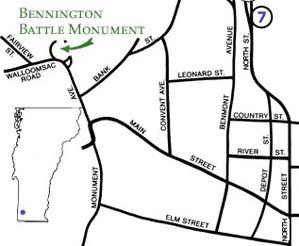
Bennington Battle Monument
15 Monument Circle
Bennington, VT 05201
DIRECTIONS:
Bennington is centered around the junction
of US Route 7 and State Route 9 in the
southwest corner of Vermont.
The Bennington Battle Monument is located at
the head of Monument Avenue on Monument Circle.
From the center of Bennington, take West Main Street
(State Route 9) going up the hill past the Bennington
Museum. At the Old First Church, take a sharp right
on to Monument Avenue; the Monument is straight ahead.
About the Bennington Battle Monument
A group wishing to commemorate the Battle of Bennington decided a monument should be erected at the storage site of the military supplies which had been the objective of the battle. In 1876, the Vermont General Assembly passed an act establishing the Bennington Battle Monument Association as an outgrowth of the Bennington Historical Society. Even earlier, in 1854 (77 years following the Battle) the Legislature of Vermont had established and founded an Association to erect a monument; but because of difficulties in raising the needed additional money, the group disbanded after two years. This new organization, with the Nation's Centennial celebration behind them and with the approach of Vermont's Centennial in 1891, aggressively worked towards the erection of a suitable memorial. The State of Vermont appropriated $15,000; New Hampshire $5,000; Massachusetts $10,000; the Congress of the United States $40,000; and with approximately $32,000 raised through private contributions, the amount of $102,000 was obtained to construct the memorial. In 1886, the Vermont Legislature authorized an additional $10,000 to purchase the property where the monument was to be erected. Meanwhile, the debate raged as to whether a sculptural or architectural monument should be constructed. After reviewing various proposals, the committee decided on the design submitted by John Phillipp Rinn, an architect from Boston. The contractor was William Ward of Lowell, Massachusetts.
The 306 foot monument features an observation deck with views of three states.
The Bennington Battle Monument is 306 feet 4 and 1/2 inches tall; the cornerstone was laid in 1887, and the monument completed and dedicated in 1891. It is constructed from blue-grey magnesian limestone (known as Sandy Hill Dolomite from present-day Hudson Falls, New York), which is roughfaced with the exception of two horizontal bands near the observatory level. The base is 37 feet square and with a gradual diminishing curve rises upward 168 feet where the rock-faced stone changes to a smooth horizontal beltcourse of 8 feet; above this is a band of rock-faced stone punctuated by twenty, eleven-foot slotted openings at the observation level. From this level, now reached by an elevator, can be seen the valleys and rolling hills of Vermont, New York and Massachusetts. Above the windows is an additional smooth beltcourse of 13 feet from which soars, uninterrupted but diminishing more rapidly, the final stone portion of 101 feet, 10 and 1/2 inches to the apex, which is surmounted by a bronze and gilt ten-point star adding the final 4 feet 6 inches to the Monument's height. The points of the star are each 18 inches long and serve as a lightning rod for the monolith, the tallest structure in the State of Vermont.
In 1952, the Bennington Monument Association transferred the ownership and operation of the Monument to the Vermont Board of Historic Sites, which later became the Vermont Division for Historic Preservation. In 1964, the State commissioned Paul V. Winters, a Vermont artist, to construct a diorama depicting the Second Engagement of the hard-fought Bennington Battle. This fine work, in full color, is historically accurate, the detail well authenticated by research. Also displayed within the Monument entrance is an immense iron kettle, which was part of the camp equipment of General Burgoyne's army at Saratoga.
On the grounds at the Monument are a number of additional monuments. The largest is the heroic figure of Seth Warner, commander of the Green Mountain Boys who helped defeat the British forces in the Second Engagement of the Battle; cut from granite, the monument was donated in 1910 by Colonel Olin Scott. Also prominently displayed is a large granite boulder with a bronze tablet, which was placed in honor of General John Stark and the 1,400 New Hampshire men who were involved in the Battle; this was donated by the Citizens of New Hampshire in 1977. In 2000 John Threlfall donated to the Monument a bronze statue of General John Stark. This statue was cast from a plaster model executed in 1889 by American sculptor Jon Rogers. Stark is in a heroic pose, stepping forward with an outstretched arm pointing towards the approaching British. A number of other memorials are on the grounds around the main monument.
The Monument Gift Shop offers a fine selection of quality merchandise relating to the Battle and the Monument. The items are indicative of the social, geographical and economic factors that occurred over a span of 114 years; from the Battle of Bennington in 1777 until the completion of the Monument in 1891.
